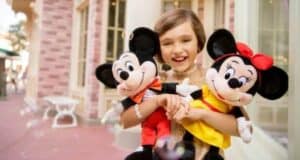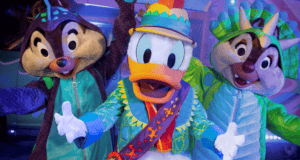
Daisy Duck is perhaps the finest waterfowl ever to grace Walt Disney cartoon classics. As Donald’s better half, she exudes her true nature as a strong supporting female that lovingly accepts her man (or duck, in this case) in good times and bad, despite his hotheaded temper and other numerous plucky quarks. A true lady in every respect, Daisy’s dainty character developments over the years have taken on many diverse forms, been reimagined and revised on more than one occasion, and have really established what is a most versatile background history studded with fun facts. While we could easily cover a plentiful profusion on that final note, here is a highlighted look at 10 fun facts you’ll want to know about Disney’s Daisy Duck.
10. Her appearance
Like Donald, Daisy’s likeness is modeled after that of a real duck—an American Pekin, to be exact. Unlike Donald, however, animators added a touch of feminine physique to Daisy’s appearance by giving her long eyelashes enhanced by colored eye shadow, no less, and incorporating other ladylike callouts through fashion. Daisy’s sense of style, while varied over the years depending on character adaptation, remains signature for the most part. When you think of Daisy, you’re likely to picture a fashionable dainty duck with a large bow plopped atop her head, a V-neck blouse, bracelet on her left wrist and high heel pump shoes to match her outfit.

9. A hatching debut
Daisy made her first official appearance as the familiar duck we know and love in the Donald Duck classic short Mr. Duck Steps Out. The cartoon was released in June of 1940. And given the fact that in most cases (unless otherwise stated specifically) a character’s official birthday is marked by their debut date, we can presume that Daisy Duck’s hatch date was on June 7, 1940.

8. Notable roles and appearances
Unlike predecessors of earlier origin (which we will cover a little later on) Daisy’s likeability landed her instant popularity, and she went on to appear in a total of 11 short films between the years of 1940 and 1954 in addition to being incorporated into various Donald Duck comics. As the decades progressed, Daisy solidified her place as one of Mickey’s extended pals with continued television and film appearances. While Daisy often appears in supporting roles, she has been known to step into the limelight on occasion. In fact, the July 11, 1947 release of the short Donald’s Dilemma even bumped her up to star status. Two months earlier, she had already played a very prominent part in the short Sleepy Time Donald. Later on, with the 2004 release of in Mickey’s Twice Upon A Christmas, Daisy Duck and Minnie Mouse battle it out quite literally as a dueling duo of protagonists in the story arc “Belles on Ice.”

Bonus Tip!
BONUS TIP: Consider planning and booking your next Disney trip with an Authorized Disney Vacation Planner you can trust like Mickey Travels. They’ll help you get the best Disney travel deal, share expert advice and their services are totally FREE! It’s genius! Discover More >
7. A duck of many quacks
Through out the years, Daisy has been voiced by many different voice personalities. For her debut performances in 1940 and 1941 Clarence Nash, the notable and established voice of Donald Duck, did double duty by lending his vocal skills to the new female duck. Therefore, in her earliest presentation, Daisy sounded much the way Donald does—unintelligible, and quacked up. She was also prone to the same quick-tempered, hotheaded reactions as her significant other. With a desire to make Daisy sound much more feminine while alluding more reasoning and rationale to her character, the decision was made to hire a female voice talent—actress Gloria Blondell. Blondell first took on the role back in 1945 and went on to become known as the first official voice of Daisy Duck, voicing her on numerous occasions between 1945 through 1947. In 1948 Ruth Clifford, who also provided the voice of Minnie Mouse for a time, briefly stepped into the role before Blondell again returned to the mic in 1950. Actress Vivi Janiss also leant her vocal talents to the Daisy Duck character back in 1954. Then prominent voice actress June Foray, best known as Rocky from The Adventures of Rocky and Bullwinkle in addition to having voiced many other characters both Disney and otherwise, filled the bill between 1959 and 1960. Another notable voice in animation, Janet Waldo stepped into the role during the year of 1974. Waldo is best known as the voice of Judy Jetson in The Jetsons along with voicing other characters in various Hanna-Barbera cartoons. Patricia Parris, whose many vocal talent credits also include works for Hanna-Barbera in addition to numerous Disney projects, voiced Daisy in 1983. Tony Anselmo, who is another voice personality most famously linked to Donald Duck in later cartoons, followed suit of Clarence Nash in lending his voice to the character of Daisy and other ducks in Down and Out With Donald Duck in 1987. Diane Michelle went on to voice Daisy between the years of 1998 and 1999 with Tress MacNeille taking the lead as the current voice of Daisy Duck since 1999 to present time. While legendary character voice actress Russi Taylor (Minnie Mouse) did lend her vocal talents to Daisy Duck’s character in Disney’s Fantasia 2000, her contribution was not a speaking part but rather a scream.

6. Gal pals
One wouldn’t have such an extensive voice history and not be considered sociable. And Daisy has many friends to prove just how very social she is. Ultimately, her very best friend of all is none other than Minnie Mouse. Other female friends she’s been known to hang about with include Clarabelle Cow and Clara Cluck.

5. The Family Flock
It goes without saying that anytime a character is developed and then incorporated into an already established storyline there are bound to be minor inconsistencies. The presentation of Daisy Duck’s family over the years has proven true in this regard but not to the extent that plausible piecemeal conclusions can’t be conceptualized. Based on what we’ve seen through Donald Duck shorts and Daisy’s appearance in comics and other works over the decades, we can conclude the following about her family. Daisy has two parents, one being a deaf mother and the other a photographer father. We first meet them in the 1954 short Donald’s Diary where we are also introduced to three younger brothers who appear similar to Huey, Dewey, and Louie. Two years earlier in the Donald Duck comic Flip Decision by Carl Banks we were also previously acquainted with Daisy’s three nieces—April, May, and June—again similar to Hewey, Dewey, and Louie. In that same storyline Daisy visits her sister, who isn’t directly seen but is the verified mother to Daisy’s nieces. Other miscellaneous family members to spring up in Daisy’s family tree later on include a cousin named Almanda de Quack and GramQuacker Lily. According to Don Rosa’s comics, Daisy also has a presumed brother, who is married to Donald’s sister and is the father of Hewey, Dewey, and Louie. This explains why the three refer to both Donald and Daisy as “aunt” and “uncle” in the majority of story arcs. It may also explain the familial similarities between them and Daisy’s younger brothers and nieces. While Donald and Daisy are most often only considered related by in-law marriages to one another’s siblings, they share the same “Duck” identifier. The explanation given by Rosa is that “Duck” is a very common surname, much the way Smith or Jones is for humans.

4. So, what is her relationship to Donald exactly?
Again there are inconsistencies at play when we examine the relationship between Donald and Daisy Duck as presented over the years in various cartoon shorts and comic adaptations. The most commonly accepted belief is that Donald and Daisy are long-term boyfriend and girlfriend. Many have questioned whether or not they are married—an idea that does not hold water with several foiling facts standing in the way of that theory, including the fact that they live in separate homes. There was one questionable short from 1959, however, that breaks with all continuity—How to Have an Accident at Work. In it, Donald and Daisy are shown as a married couple and even have a toddler son! But that was the first and last time we saw such a depiction. Besides, Donald’s earlier views on marriage as envisioned by him in Donald’s Diary were not too favorable, so perhaps he has commitment issues but is still prone to wonder and daydream about the institution and that is what we are seeing highlighted here. Another less welcome scenario once proposed to explain their common last name is that Donald and Daisy are really just second cousins. But that concept just induces more continuity errors based on cartoon depictions of them undeniably being portrayed as a couple. That is why Dan Rosa’s aforementioned explanation on the Duck surname and published Duck family tree highlighting the Donald/Daisy in-law connection is the best one received by longtime Disney fans.

3. Not Donald’s first love?
While we can conclude that Daisy is Donald’s well-recognized significant other, many have come to wonder whether she’s actually Donald’s first and only love. An earlier cartoon predating Daisy’s first “official” appearance as the familiar Daisy Duck we all know and love today sparks that debate. The cartoon in question, Don Donald, was released in 1937. In it, Donald is courting a female duck named Donna, somewhere in Mexico. Also voiced by Clarence Nash, Donna is portrayed as a squabbling, hotheaded, female version of Donald Duck. So, aside from physical appearance, Donna and Daisy have very little in common by way of character traits. It’s undeniable that Donna’s conceptualization worked to influence the eventual, more substantial recurring portrayal of Daisy Duck three years afterward, but to argue whether or not they are the same remains a viable Disney debate even to this day. As it stands, Donna’s appearance was not only a one-time thing. Between May and August of 1937, she was even featured in a comic strip titled Donald and Donna, published in Mickey Mouse Weekly. Later on, in 1951, the idea of Donna’s presence and character were reimagined for Disney comic strips, structuring her to be a rival to Daisy Duck and a confirmed separate duck altogether. Some even go so far as to say that Donna may actually be Daisy’s sister—that unnamed sister we heard about—the mother to Daisy’s nieces April, May, and June.

2. A versatile resume
During her tenure as a classic Disney character Daisy has taken on a wide range of occupations as presented through various televised portrayals. Disney’s Quack Pack series back in 1996 shows Daisy as an independent, sophisticated newscaster. During the “Mickey & Minnie’s Gift of the Magi” segment of Mickey’s Once Upon A Christmas, which was released in 1999, we briefly see Daisy working alongside Minnie at Mortimer’s Department Store. Later in Disney’s House of Mouse series Daisy is seen filling the role of reservation clerk for the main operating club. The Mickey Mouse Clubhouse series, which aired back in 2006 on Playhouse Disney, placed Daisy in a more lucrative though discrete role—one as a secret spy. Later on, in Minnie’s Bow-Toons—a series that ran from 2011 to 2016, Daisy has presumably returned to her earlier department store calling, as we find her an employee at Minnie’s Bow-Tique. Another side note regarding Daisy’s profuse professions, in the now defunct online Toontown roleplaying site, Daisy Duck was in charge of the Daisy Gardens playground.

1. A superhero alter ego
While Daisy has taken on a wide range of versatile careers through the years, it is perhaps her work fighting crime as a superhero that ranks most unique. That’s right, Daisy Duck has been featured as having a superheroine alter ego in the Italian Paperinik comics since the early 1970s. She came on the scene as Paperinika or “Super Daisy” not long after Donald Duck’s first introduction as the title character “Paperinik” in 1969. It should be noted that neither Paperinik nor his girlfriend Paperinika actually possess any superpowers. Their alter egos are more in par with Batman in that respect. Because the original comic story was an attempt to vindicate the often unlucky Donald Duck with a caped “Duck Avenger” alter ego that lands him favor as a winner (though incognito), Super Daisy’s presence ended up outshining Donald in the end. So once again Donald was reduced to a redundant loser status in comparison to Daisy’s having saved the day and getting all the glory. This largely upset many young Donald Duck fans, resulting in a discontinuation of Super Daisy being featured in Italian comics. She is, however, still featured in the Brazilian storyline, which also includes “Super Goof” (Goofy’s alter ego) and other Disney characters.

As we can see, Daisy’s dynamic character runs deep beyond her feathers and fashion. She remains a versatile, beloved, and iconic classic Disney character many fans continue to flock to. With that, it can be concluded that with Daisy’s ongoing favorable status and continued spunky performances, she is by no means a lame duck.



